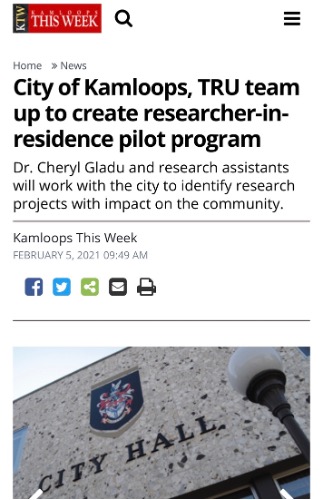Researcher-in-Residence Initiative
The “Researcher-in-Residence Initiative in Cultural Mapping, Economic Development, Social Inclusion, and Urban Planning” works toward the integration of community-engaged research practices over a significant period of time and in a manner meaningful to the City’s cultural, economic development, and community planning and policy processes.
Introduction to the Initiative
The Researcher-in-Residence (RiR) Initiative is built upon working partnerships previously established through two nationally-funded Community-University Research Alliance (CURA) grants, both focusing on mapping the culture of small cities.
Two research MOUs, one with the United Way and one with the City of Kamloops, have extended these partnerships, with the University taking a lead role in highlighting social innovation and community-engaged research as priority areas.
Working together with these partners, and as a result of our recent scholarship, we were invited by the City of Kamloops (British Columbia, Canada) to further animate community-engaged research and cultural mapping methodologies as strategies for addressing social and cultural problems arising from the dual crisis of opioid overdoses and COVID-19.
The RiR began in January, 2021, and has resulted in meaningful student training and class participation of 44 students in city projects/problems; the mapping of lived and living experiences of the toxic drug overdose crisis in small cities; the co-development of the City’s Cultural Strategic Plan; the ongoing mapping of the Kamloops housing continuum; the generation of 12 areas of potential research collaboration; and key projects on municipal climate governance, change management at the City of Kamloops, and equity, diversity and inclusion at the City.
The RiR is helping establish a new model for enhanced participatory decision-making specific to small cities, a model publicly endorsed by the City’s Mayor, City Council, and Senior Management; with Mitacs identifying TRU’s RiR Initiative as an exemplary model at the 2021 and 2022 Meetings of the Federation of Canadian Municipalities, and inviting to showcase the project in a national webinar series; and receipt of early recognition through two national awards of excellence.

Research Program and Significance
The Researcher-in-Residence Initiative is more than a collaborative community-university partnership; it is a research program. This research program begins with the proposition that small cities are increasingly challenged to develop cultural and social policies—and related cultural policy research methodologies—that are expected to work with (or for) other policy areas such as economic development, social inclusion, and urban planning.
Cultural mapping provides a ready approach and platform for this intersectoral work. As a field of inquiry, cultural mapping represents two interrelated areas of study and practice: The first focuses on cultural assets, identifying, locating and quantifying tangible and intangible assets, typically with the aim of developing a cultural resource or community asset map. The second area, associated with the rise of critical cartography, employs participatory mapping techniques to create a multivocal community narrative of place, bringing stakeholders together in purposeful conversation and group problem solving.
Taken together, the two areas of cultural mapping seek to combine the tools of modern cartography with vernacular and participatory methods of storytelling to represent spatially, visually, and textually the authentic knowledge, assets, values, views, and memories of local communities. Both forms of mapping have become increasingly employed by governments, most notably municipalities, and by academics worldwide, often under the premise that they promise an ability to engage and connect with populations and communities not normally inclined towards political/academic participation.
Our Projects
Our projects seek impactful social change in multiple fields
You are Here
The You are Here project explores how cultural mapping and community-engaged research can inform the development of the City’s new Cultural Strategic Plan.
Linking the RiR to city-driven project work provides an in-depth opportunity for partnership development, networking and intersectoral team building—creating real world opportunities to complement or replace more top-down public consultation methodologies (e.g., the survey, the public hearing, and the expert-led focus group), all the while affording enhanced student training opportunities and increasing participation of those with lived/living experience.


Cultural Mapping
Lived & Living Experiences
“Cultural Mapping Lived/Living Experiences of the Toxic Drug Overdose Crisis in BC’s Small Cities” uses cultural mapping to focus on the toxic drug overdose crisis in our communities. The project is working with populations in Kamloops, Comox Valley, Campbell River, and other communities. The purpose is to use cultural mapping to better understand the crisis through the lens of those directly impacted. An effective response requires the development of shared community understanding and a belief that a coordinated implementation of good policies and actions can produce positive change.
Our current focus is on those working in the Trades: Trades training programs in both universities and schools do not typically include a focus on drugs as part of their curricula. Inclusion of such educational material, if drawn from the lived and living experience of those working in the trades, would likely have a profound impact on the next generation of trades workers
Mapping Equity, Diversity, and Inclusion
Project EDI involves students, validates their experiences and insights, moves beyond mere EDI compliance, and, when done well, helps build an inclusive community. Capturing the local EDI landscape visually, in writing, and in conversation with students, their teachers and administrators, cultural mapping presents an innovative and even necessary complement to existing EDI approaches. The mapping makes individual experiences visible and public, keeping them local and inclusive.
The Pride Project, also featured here, began with an invitation. The Director and Curator of the Salmon Arm Arts Council and Gallery wanted to extend the community’s Pride Week celebrations and exhibition by adding a research component. They wanted to know how cultural mapping might help provide evidence for progressive policy change—to create safer cultural spaces for the City’s LGBTQ2S+ Community.
The EmpowerHer Project (2018) involved two of our artist-researchers working in collaboration with the United Way to explore and document women’s perceptions and attachments to place. This arts-informed approach to cultural mapping engaged over 700 women, with the aim of recentring the voices, everyday knowledge, and authority of these women in relationship to place.
